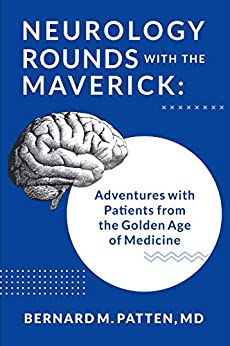A book review of Neurology Rounds with the Maverick: Adventures with Patients from the Golden Age of Medicine by Bernard M. Patten, MD

Stars: **
Identity Publications (2019)
Memoir
380 pages
Disclosure: I received a copy of this book in exchange for an honest review. This post contains affiliate links.
Summary: In Neurology Rounds with the Maverick, clinical neurologist Dr. Bernard M. Patten recounts his most profound, entertaining, and uncommon experiences with patients throughout his 34-year medical career.
Learn about the strange case of the teenage girl who got pulled out of class for medical treatment because she couldn’t stop laughing. Then consider the 14-year-old who faked grand mal seizures for more than a year to get away from her sexually abusive father.
Consider the awkward situation of the hairdresser who heard voices from God instructing her to stab her customers with her scissors or the well-documented phenomenon of patients (including Dr. Patten’s own mother) correctly predicting their own deaths.
Read Dr. Patten’s encounters with artist George Rodrigue as he lost his memory and physicist Stephen Hawking when he was considering experimental ALS treatment. As well, enjoy learning about when Russian composer Dmitri Shostakovich came to America to be treated for atrophy in his right hand and shipping magnate Aristotle Socrates Onassis’s consultations about Myasthenia Gravis.
Neurology Rounds with the Maverick presents an authentic look inside some of the most complex, strange, and fascinating neurological cases of the last half-century of medicine. Read it to appreciate the good, the bad, the terrible, and the densely human anecdotes that document the past and light the way for the future of medicine
Neurology Rounds with the Maverick
I struggled with this book. The stories themselves were very interesting. The way the brain can get messed up provides for some entertaining stories although I’m sure it wasn’t entertaining to those struggling with the problems.
HOWEVER, I had issues with the attitude of the author and the way he described certain people.
Part of his word choice is probably because he’s from an older generation where certain words were okay to use but this book was written recently. He should have made sure his words were appropriate to this time. For example he calls Stephen Hawking a cripple. We don’t really use that word anymore. Every time a patient is black, his or her skin colour is mentioned, even if it’s not relevant. He doesn’t mention skin colour for other people.
He also flip flops between his view on religion. At one point he goes on about how it bothered him that a patient was praising God for being able to walk again because it was him that did the curing, not God (according to him.) Then later in a few other different parts he mentions Jesus and God as if he is a believer.
At one point a patient is concerned that he (Doctor Patten) thinks she is crazy. His response is “I don’t think you’re crazy. I know you’re crazy.” In another spot he refers to a woman he later finds out is pregnant as “a big-as-a-house black mama.” Finally when he is talking about the girl who first got him interested in neurological conditions (and whom he develops feelings for), he says, “She was cow heavy and fat, and she was ugly too.”
That’s just a small sample of the issues I had with the author. As I said, all the stories were interesting, even amazing. But reading it was like trying to play in a field of land mines and trying to not to hit them.
If this book went through a rewrite with an editor, it could be a great book.
Find this book on Goodreads.








